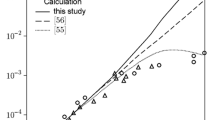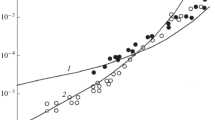Abstract
A family of axisymmetric Laval nozzles with a central cylindrical part is considered. The nozzle diffuser with relatively small dimensions ensures stable detonation combustion of kerosene vapor behind an inclined shock front that forms before entering the combustion chamber without auxiliary initiating structures and additional energy supply. Modeling is carried out based on the two-dimensional unsteady Euler equations of motion for axisymmetric flows of a multicomponent gas and a simplified kinetic scheme of chemical transformations. The calculations are performed using a modified numerical scheme by S.K. Godunov of the second order of accuracy in spatial variables. It is shown that effective detonation combustion occurs on the impact of the initiating shock front on the wall of the combustion chamber in the immediate vicinity of the corner point of conjugation with the diffuser. The parameters of a number of nozzles are determined, in which the detonation combustion of kerosene vapor provides high power characteristics with an efficiency of more than 40% in atmospheric air at an altitude of about 40 km at a flight Mach number of M0 = 9.








Similar content being viewed by others
REFERENCES
Ya. B. Zel’dovich, Zh. Tekh. Fiz. 10, 1453 (1940).
Yu. V. Tunik and V. O. Mayorov, Acta Astronaut. 194, 488 (2022). https://doi.org/10.1016/j.actaastro.2021.09.038
G. Wang, W. Liu, S. Liu, H. Zhang, H. Peng, and Y. Zhou, Acta Astronaut. 189, 722 (2021).
S. M. Frolov, V. S. Aksenov, and V. S. Ivanov, Russ. J. Phys. Chem. B 5, 664 (2011).
N. N. Smirnov, V. F. Nikitin, L. I. Stamov, E. V. Mikhalchenko, and V. V. Tyurenkova, Acta Astronaut. 163, 168 (2019).
Yu. V. Tunik, G. Ya. Gerasimov, and V. Yu. Levashov, Russ. J. Phys. Chem. B 15, 801 (2021).
Yu. V. Tunik, G. Ya. Gerasimov, V. Yu. Levashov, and N. A. Slavinskaya, Combust. Explos., Shock Waves 56, 344 (2020).
Yu. V. Tunik, G. Ya. Gerasimov, V. Yu. Levashov, and M. S. Assad, High Temp. 59 (2021, in press).
X. Shi, H. Xie, L. Zhou, and Y. Zhang, Acta Astronaut. 190, 342 (2022).
G. Xiang, H. Li, G. Zhang, X. Xie, and Y. Zhang, Int. J. Hydrogen Energy 46, 17435 (2021).
Q. Qin and X. Zhang, Int. J. Hydrogen Energy 44, 17004 (2019).
G. G. Chernyi, Gas Dynamics (Nauka, Moscow, 1988) [in Russian].
M. A. Zubin and Yu. V. Tunik, Fluid Dyn. 49, 557 (2014).
M. A. Zubin and Yu. V. Tunik, Fiz.-Khim. Kinet. Gaz. Din. 16 (3), 1 (2015).
Yu. V. Tunik, Comput. Math. Math. Phys. 58, 1573 (2018).
Yu. V. Tunik, Fiz.-Khim. Kinet. Gaz. Din. 19 (1), 1 (2018).
V. E. Kozlov, N. S. Titova, and S. A. Torokhov, Russ. J. Phys. Chem. B 14, 395 (2020).
N. A. Slavinskaya, AIAA Paper No. 2008-992.
Y. Yan, Y. Liu, D. Di, C. Dai, and J. Li, Energy Fuels 30, 10847 (2016).
K. L. Tay, W. Yang, B. Mohan, et al., Energy Convers. Manage. 108, 446 (2016).
A. Burcat and B. Ruscic, Tech. Rep. No. ANL-05/20, TAE 960 (Argonne Natl. Labor., Lemont, IL, USA, 2005).
Y. Chang, M. Jia, Y. Liu, Y. Li, and M. Xie, Combust. Flame 160, 1315 (2013).
A. J. Dean, O. G. Penyazkov, K. L. Sevruk, and B. Varatharajan, Proc. Combust. Inst. 31, 2481 (2007).
H. Wang and M. A. Oehlschlaeger, Fuel 98, 249 (2012).
N. P. Isakova, A. N. Kraiko, K. S. P’yankov, and N. I. Tillyaeva, J. Appl. Math. Mech. 76, 451 (2012).
Yu. V. Tunik, Fluid Dyn. 49, 688 (2014).
Funding
This study was financially supported by the Russian Foundation for Basic Research (grant no. 20-51-00003 (Bel_a)) and as part of a state task of the Ministry of Science and Higher Education of the Russian Federation “Experimental and Theoretical Study of Kinetic Processes in Gases” (registration number AAAA-A19 -119012990112-4).
Author information
Authors and Affiliations
Corresponding author
Rights and permissions
About this article
Cite this article
Tunik, Y.V., Gerasimov, G.Y., Levashov, V.Y. et al. Initiation of Stable Detonation Combustion of Kerosene Vapors behind an Oblique Shock Wave in a Rarefied Atmosphere. Russ. J. Phys. Chem. B 16, 699–705 (2022). https://doi.org/10.1134/S1990793122040327
Received:
Revised:
Accepted:
Published:
Issue Date:
DOI: https://doi.org/10.1134/S1990793122040327




